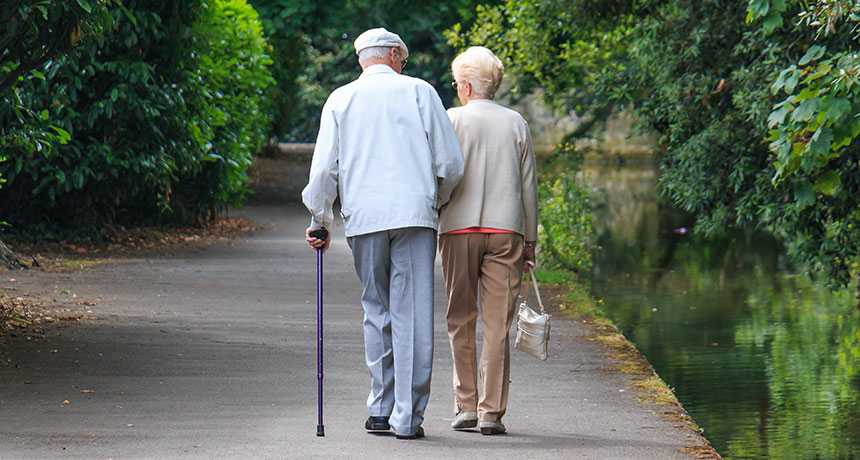
Princeton University report: US class-based life expectancy gap widened to more than 8 years
BY Benjamin Mateus
The recent report by leading Princeton University economists Anne Case and Angus Deaton (winner of the Nobel Prize in 2015), submitted last month to the fall 2023 edition of the Brookings Papers on Economic Activity, makes a conscientious account of the widening mortality gap that exists between Americans with and without a four-year college degree, a proxy for their socioeconomic positions.
Their primary findings showed that the difference in life expectancy between these two groups has grown from just 2.5 years in 1992 to a staggering 8.5 years by 2021. While those who have obtained a higher education can expect to live to 83.31 years of age, the two-thirds of Americans without a bachelor’s degree will see, on average, life end at 74.82 years of age.
The research recently presented at the Brookings Institution is the latest contribution to the ongoing collaboration between the two economists who have been attempting to address for nearly a decade why the US has faced a decline in life expectancy compared to other high-income nations. In particular, Case and Deaton place into context the decline in life expectancy being observed among less educated working-class Americans while at the same time the growth in gross domestic product (GDP) is outperforming other countries and US economic output is the highest in the world, accounting for 25 percent of global GDP.
During an interview with the Brookings Institution, Anne Case noted, “GDP may be doing great, but people are dying in increasing numbers, especially less educated people. A lot of the increasing prosperity is going to the well-educated elites. It is not going to typical working people.” With these deaths being concentrated among non-Hispanic whites, the phenomenon being observed has more to do with how marginalized working class Americans are being treated and less to do with the constant fixation on race as propagandized in the bourgeois press.
In their opinion piece published on October 3, 2023, in the New York Times, Case and Deaton wrote, “What the economic statistics obscure in the averages is that there is not one but two Americas—and a clear line demarcating the division is educational attainment. Americans with four-year college degrees are flourishing economically, while those without are struggling.”
They then added, “Worse still, as we discovered in new research, the America of those without college degrees has been scarred by death and staggeringly shorter life spans. Almost two-thirds of American adults do not have college degrees, and they have become increasingly excluded from good jobs, political power, and social esteem. As their lives and livelihood are threatened, their longevity declines.”
The findings of the 2023 report
The study makes an exhaustive analysis of mortality by reviewing the death certificates of Americans from 1992 through 2021, which include the first two years of the COVID pandemic. As they note, these documents record the age and sex, cause of death, as well as the highest education attained. Furthermore, they calculate life expectancy at age 25, when most people have completed their education and the distinction between those without and with a bachelor’s degree is more clearly demarcated. The assumption they make in their analysis is that after age 25 the likelihood to attain higher education is considerably diminished.
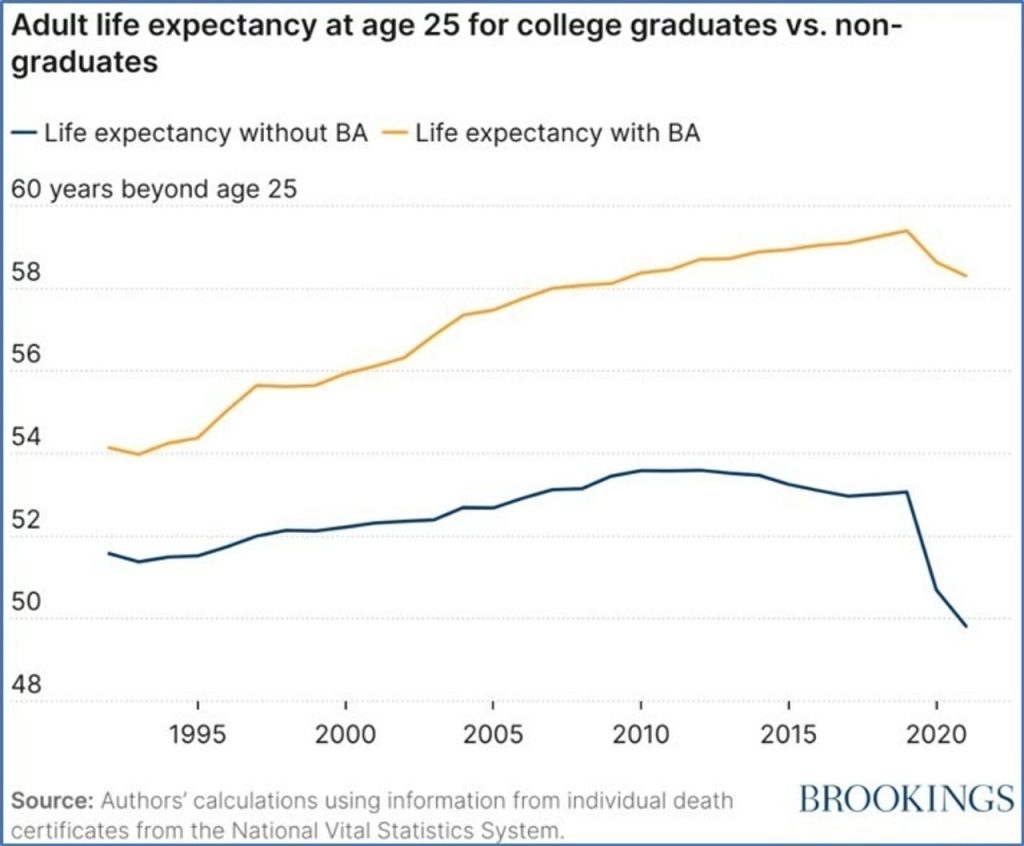
As their Figure 1 shows, since 1992 (when data was first available), the gap in mortality between the two groups begins to widen, though both continue to make gains until approximately 2010. After the financial crisis of 2008 and the bailout of the banks, those without a college degree saw their life expectancy begin to decline while for those with a college education it continued to climb although at a slower pace. Then in 2020, with the advent of the global COVID pandemic, those without a college degree saw life expectancy plummet by 3.25 years while those with a degree saw their life expectancy drop by 1.09 years. Indeed, the age-adjusted mortality for COVID deaths was 165 versus 57 per 100,000 or almost three-fold higher between the two groups. (Data from table 1 of the Case/Deaton report.)
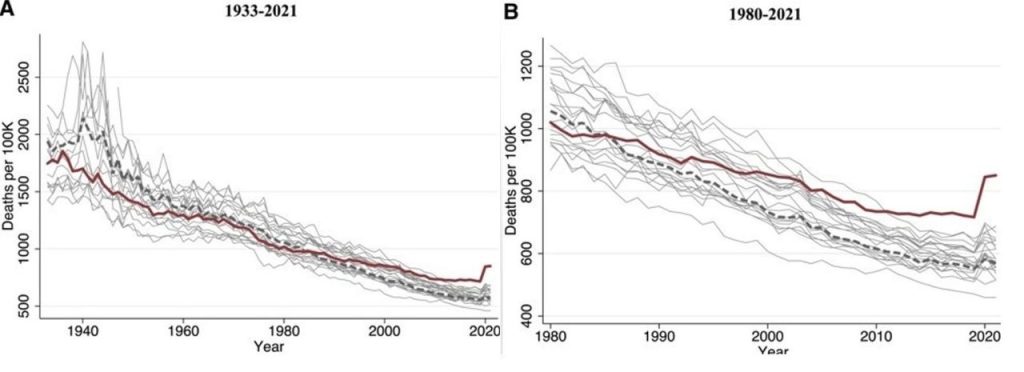
As the figure above from a May report published in PNAS, titled “Missing Americans: Early death in the United States—1933-2021” depicts, during the post-war period and short-term capitalist stabilization, the gains in life expectancy in the US paralleled those in Western Europe. However, from the early ’70s, with the dollar crisis emerging and the ending of the Bretton Woods agreement pegging dollar exchange rates to gold to the mid-’70s and the ensuing financial crisis, any further concessions by the ruling elites to the working class that saw their earnings and quality of life keep pace had to come to a halt.
The intensification and deepening of the exploitation of workers since then has led to an unprecedented transfer of wealth. For families in the top 10 percent, this layer saw their combined wealth increase from $24.3 trillion to $82.4 trillion from 1989 to 2019. Those in the 51st to 90th percentiles increased their wealth from $12.7 trillion to $30.2 trillion. Meanwhile, those in the bottom half saw their wealth barely budge, rising from $1.4 trillion to $2.3 trillion, but actually declining by nearly half as a proportion of all wealth, from 3.6 percent to 2.0 percent (data from Congressional Budget Office).
By 2010, the gains made in life expectancy in the US had not only dropped below other high-income countries, but it had essentially stalled. However, when Case and Deaton overlaid their graphs for those with and without a college degree what emerged was astounding.
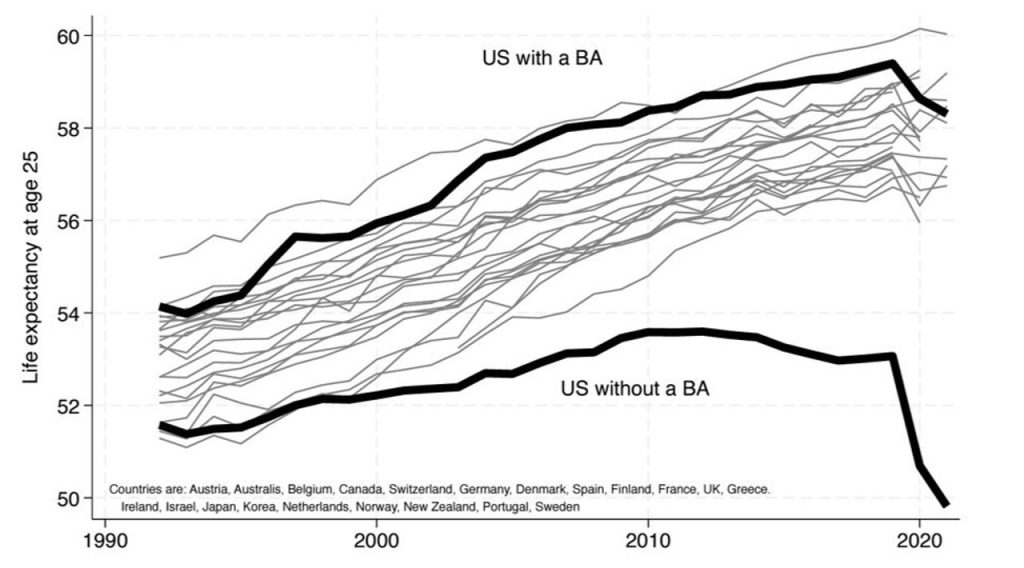
By the early 1990s, the gains in life expectancy for those without a college degree began to diverge and falling below the leading nations before 2000. Indeed, by 2010 when mortality rates began to climb, this group never even reached the life expectancy levels experienced by college graduates in 1992. However, for those with a college degree, life expectancy continued to trend alongside the best performers, hence, the apt reference by Case and Deaton to the “two Americas.”
Given that there have been, between 1980 and 2019, 11 million excess US deaths, as noted in the report on “missing Americans,” the lion’s share of this staggering loss of life then was borne by those without a college education. In fact, the entire decline in life expectancy in the last 30 years is attributable to the socioeconomic dynamics that fell on the working class.
Indeed, if one were to ask how these “two Americas” fare, those with a college education are comparable to Japan, Switzerland, South Korea, Norway and Iceland. Those without a college education could be compared to countries in Eastern Europe, North Africa and the Middle East. They would lead North Korea by just under two years.
Interestingly, Case and Deaton proceed along the counterfactual, asking what would have happened if rates of deaths of despair, such as suicide, drug overdose and alcoholism and mortality from cardiovascular diseases or cancers were held at their 1992 baselines? Even excluding COVID deaths, the mortality gap continued to climb for those without a higher education.
While deaths of despair accrued predominately for those without a college education, the benefits attained from advances made in treatment of heart disease and cancer went mostly to those with a college education regardless of gender.
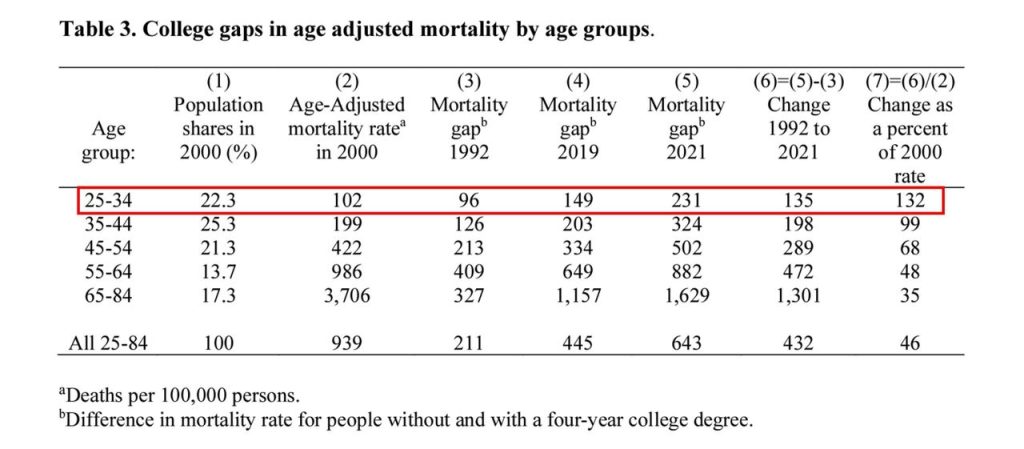
Even when the age-adjusted mortality was grouped by age brackets, the mortality gap increased over the three decades and was further exacerbated by the COVID pandemic. As the authors noted, “As a percentage of baseline mortality, younger age groups saw larger increases in education gradients over this period; for the age group 25 to 34, the increase in the gap exceeds baseline mortality [emphasis added]. Two-thirds of the increase among the youngest group was from deaths of despair.”
Indeed, rates of suicide and homicide for youth and young adults have been climbing in the last decade. The provisional rate according to the Centers for Disease Control and Prevention (CDC) was nearly 50,000 for 2022. Meanwhile, 2023 is on track for another devastating year for drug overdoses with 111,000 people dying in the last 12 months. Overdoses jumped 30 percent between 2019 and 2020 and then another 15 percent between 2020 and 2021.
Case and Deaton, alongside the widening mortality gap, also take stock in the social determinants of the population’s well-being such as looking at marriage rates, extreme mental distress, sciatic pain and difficulty socializing. The data indicate that those without an education are facing hardships that further undermine their well-being, making the promise of the pursuit of happiness a farcical insult created out of the mirage called the American dream.
The authors note that since 1970, those without a college degree have seen their median incomes stagnate for nearly half a century. Meanwhile, those families with a member with a college degree have seen their wealth climb 24 percent. Where wealth was held equally between the two groups in 1990, three-quarters of the wealth is now owned by college graduates. In simple terms, the mortality gap has followed the wealth gap.
Case and Deaton call for the defense of capitalism and reform
Like many principled academic researchers, Case and Deaton’s study provides significant insight into the social ailments caused by capitalist relations. They are meticulous in their research and elucidate through careful analysis the realities faced by the underprivileged. However, having arrived at these results, like so many others, they turn back from the edge of the precipice and fail to make the necessary conclusions.
As upholders of capitalism, they look to combining stark depictions and stern warnings with mild reforms. In the preface to their 2020 book, Deaths of Despair and the Future of Capitalism, they wrote, “We believe in capitalism, and we continue to believe that globalization and technical change can be managed to the general benefit. Capitalism does not have to work as it does in America today. It does not need to be abolished, but it should be redirected to work in the public interest.”
The graphs above are not simply shifts in life expectancy as they underscore the very real divergence in equality that manifests in real-life consequences such as poor health, mental distress and a shorter life. To assert that these are merely mistakes made by captains of industry in their direction of capitalist relations is to turn a blind eye to the real nature of capitalism and the history of the class struggle in the last 200 years.
Indeed, the data in these graphs clearly demonstrate why these historic surges in the class struggle that are occurring in every industry across every country are taking place. Simply put, workers are facing an existential threat to their existence.
Meanwhile, those in academia and the upper 10 percent, who have made substantial gains until now, fear the loss of their petty personal wealth. They have turned to weaponizing gender and race to maintain their unsteady hold on the crumbs they have managed to accumulate from the table of the financial aristocracy.
The privately owned banks and corporations, which have tremendous influence over the entire political edifice of the state, are, in the final analysis, themselves enchained by the contradictions of diminishing rates of profit and seek to extract ever more surplus value from workers to secure their profits.
Case and Deaton have taken great pains to expose inequality. Their appealing to the better nature of the capitalists to make capitalism work for everyone only undermines their analysis which, when considered carefully, raises the most pressing revolutionary questions.
The International Committee of the Fourth International declared that the COVID pandemic was a trigger event in world history. Indeed, the need for an internationally coordinated response, to bring all the resources of the world to bear and begin to save and protect lives, was completely disregarded. Instead, the capitalists took the opportunity to siphon trillions more into their coffers while allowing the population to face the onslaught from a deadly virus that has taken the lives of an estimated 27 million people in less than four years.
Beyond exposing the malign neglect of imperialist governments, the pandemic accelerated the decay of capitalist relations, setting the stage for a global conflagration and return to fascistic and dictatorial forms of rule. The war in Ukraine between Russia and the US- and EU-led NATO, and now the genocidal attack on the people of Palestine, only underscore the deep chasm that separates the international working class from the financial elites and the pseudo-left and union bureaucrats who are unable to make any credible defense of capitalism.
The working class is finding it has had enough.
[This article was originally published by WSWS here on October 23, 2023. Featured image courtesy of CEDRIC E/SHUTTERSTOCK]

